レップス・エストニア共和国教育研究大臣一行の来学Estonian Education and Research Minister and her delegation visited Tokyo Geidai
October 12, 2017
9月29日、エストニア共和国よりマイリス・レップス教育研究大臣以下、テア・ヴァラック教育研究省副大臣、アネリ・ローセ教育研究省国際協力アドバイザー、アンネ・ピッコブ国立アートアカデミー学術担当副学長、ヘンリーデイビッド・ヴァレマ国立音楽劇場アカデミー芸術・国際担当副学長、アルゴ・カングロ駐日エストニア共和国大使館参事官が、エストニアの芸術系大学と本学との間の今後の交流や協力を強化するため、本学を訪問されました。本学からは、岡本美津子副学長(国際・ダイバーシティ推進担当)、日比野克彦美術学部長、横田揺子グローバルサポートセンター特任准教授が一行をお迎えしました。
はじめに、岡本副学長より、レップス大臣御一行の来学を心より歓迎する旨の挨拶に続いて、本学は2学部4研究科から成る総合芸術大学であり、70を越える国際交流協定校・機関を持ち、文部科学省の『スーパーグローバル大学創成支援』事業にも採択され、海外最高峰の芸術系大学との国際共同カリキュラムの構築や海外から招聘した一線級アーティストによる指導を行うなど通じて、世界最高水準の教育環境の整備に取り組んでいるとの紹介がありました。
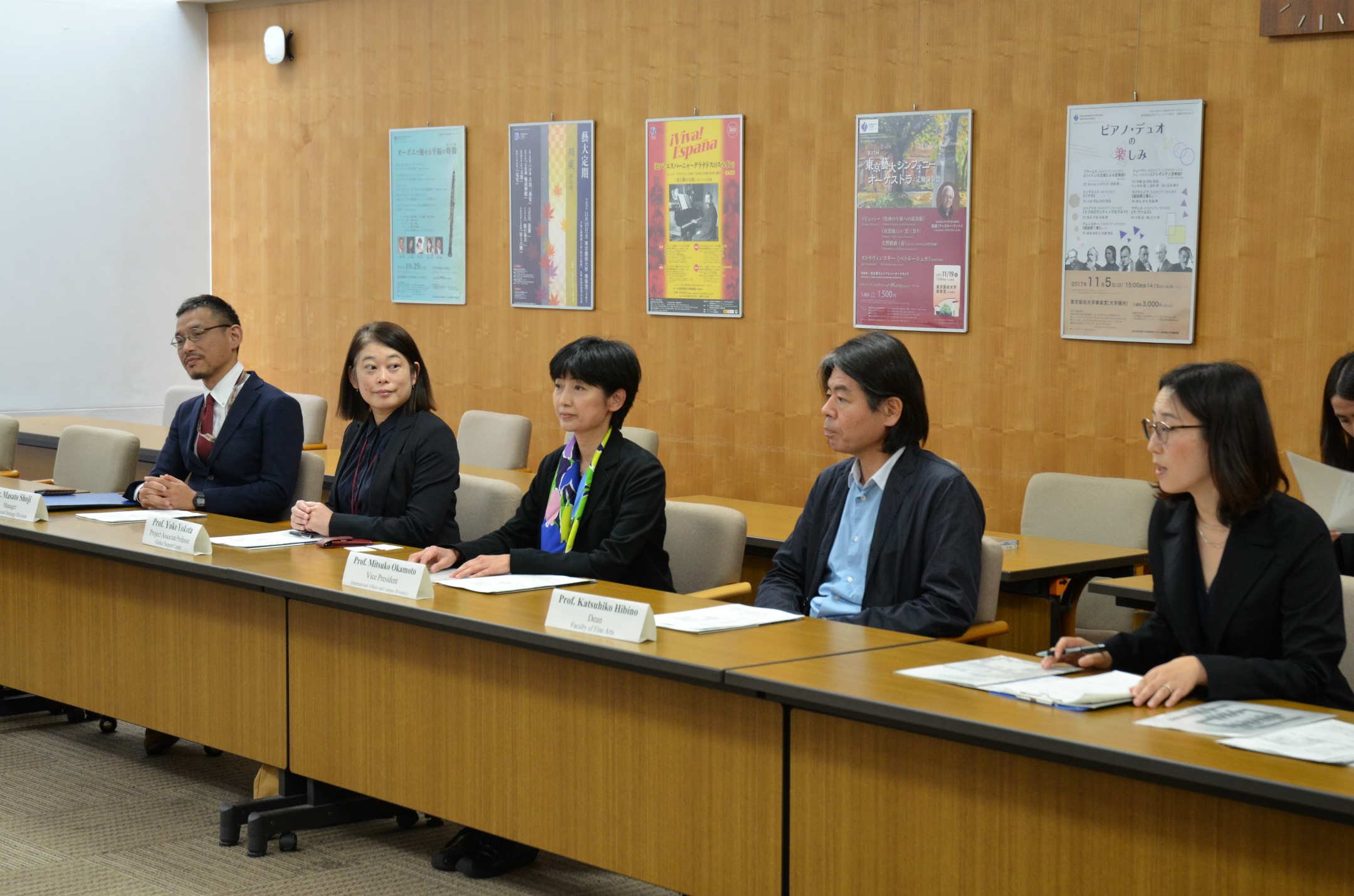
(左から)庄司国際企画課長、横田特任准教授、岡本副学長、日比野学部長、榎本理弥子グローバルサポートセンター特任助教
レップス大臣からは、同行しているピッコブ副学長とヴァレマ副学長は、欧州の大学間競争が加速する中、まだ交流が進んでいないアジア圏の大学、 中でも日本の大学との交流を深めたいと考えて訪問したと訪問目的が述べられました。

レップス教育研究大臣
続いて、ピッコブ副学長より、アジアの大学を中心に世界との繋がりを作りたい、特にデザインやアニメーションの分野での協力関係を強めたいとの希望が述べられると、日比野学部長から、日本では「生活の中に美がある」という感性があることから、職人はアーティストでもあり、その位置付けは高いなど日本の美術観も合わせて説明しつつ、藝大の美術分野の特徴の一つとして「工芸」を取り扱っていることがあると紹介がありました。
また、アニメーションの分野について、岡本副学長は日中韓の芸術系大学の学生・教員が共同で制作活動を行う『日中韓学生アニメーション共同制作』事業を事例として取り上げ、今後ともこの様な国際的な学生交流活動を積極的に展開していきたいと語りました。
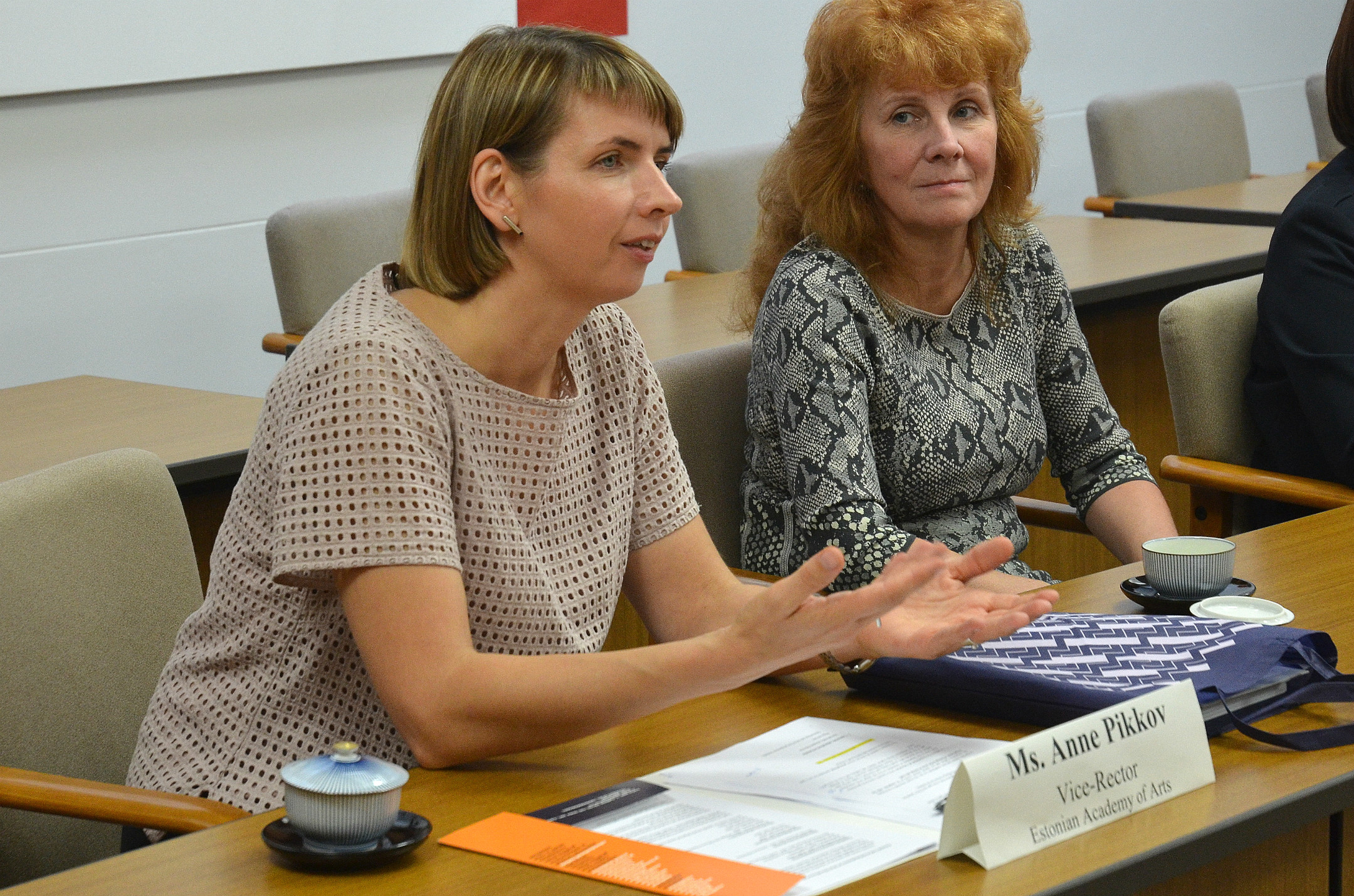
ピッコブ国立アートアカデミー副学長
ヴァレマ副学長は、国立音楽劇場アカデミーは学生の4分の1が留学生であり、授業の多くは英語で行っていると説明するとともに、日本の音楽教育のレベルが高いことに触れ、藝大とは学生、教員、研究などにおいて協力をしていきたいとの希望を語られました。これに対して、横田特任准教授は藝大の音楽分野では、交流のある海外の大学等から先生を招聘しての授業や、年2~3回は協定校との交換演奏会を実施していることなど国際交流が活発であるなどの状況を説明するとともにエストニアの音楽の歴史と伝統に触れ、交流に興味を抱く学生も多いのでは、と今後の交流発展への期待を述べました。
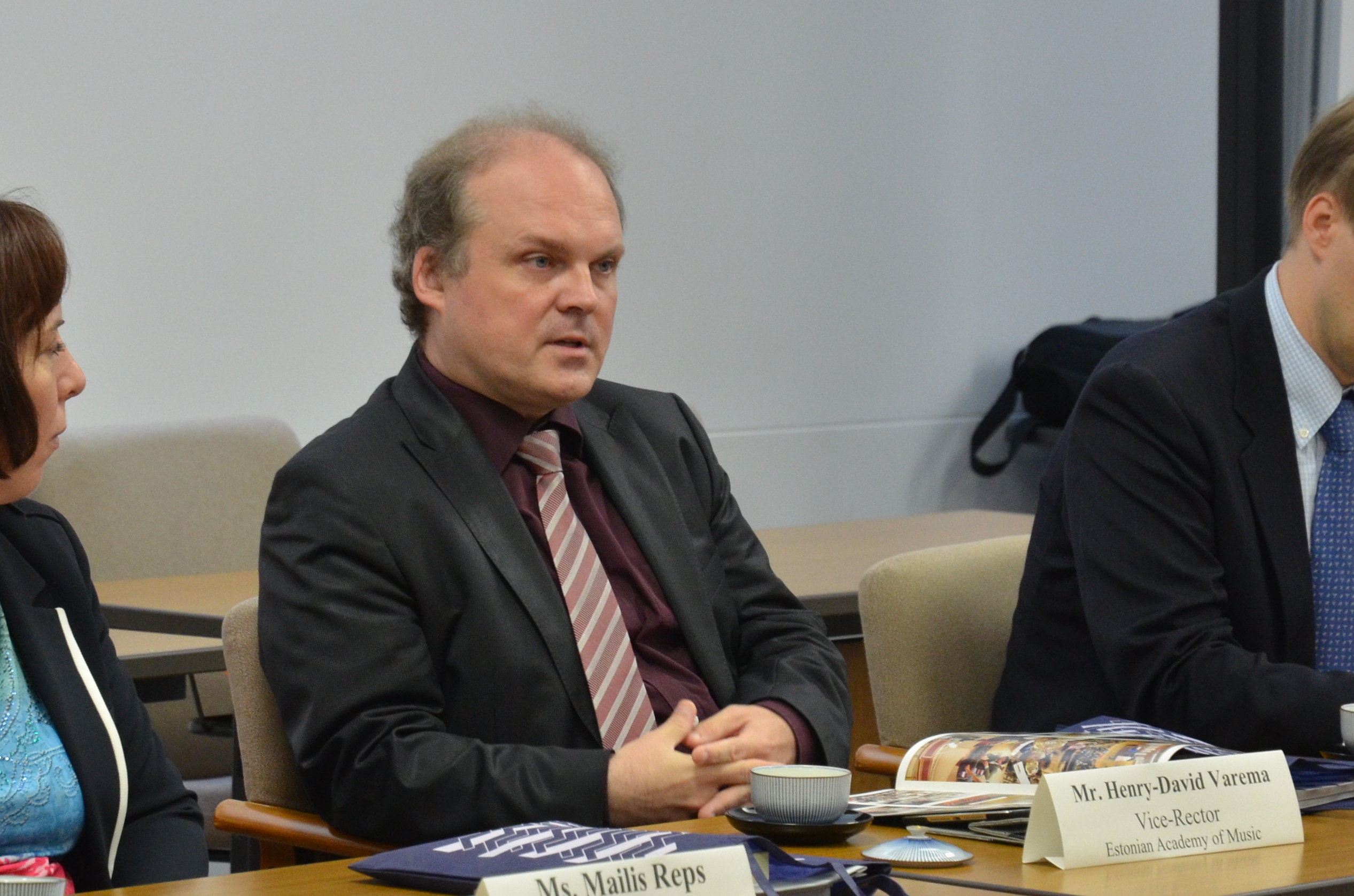
ヴァレマ国立音楽劇場アカデミー副学長
懇談後、一行は大学美術館へ移動し、宮廻正明社会連携センター長の案内でシルクロード特別企画展『素心伝心-クローン文化財 失われた刻の再生』を鑑賞されました。「クローン文化財」の技術はオリジナルと同素材、同質感であるだけでなく、技法、文化的背景、精神性など芸術のDNAに至るまでを再現するものであるとの宮廻センター長の説明に、レップス大臣は熱心に聞き入っておられました。
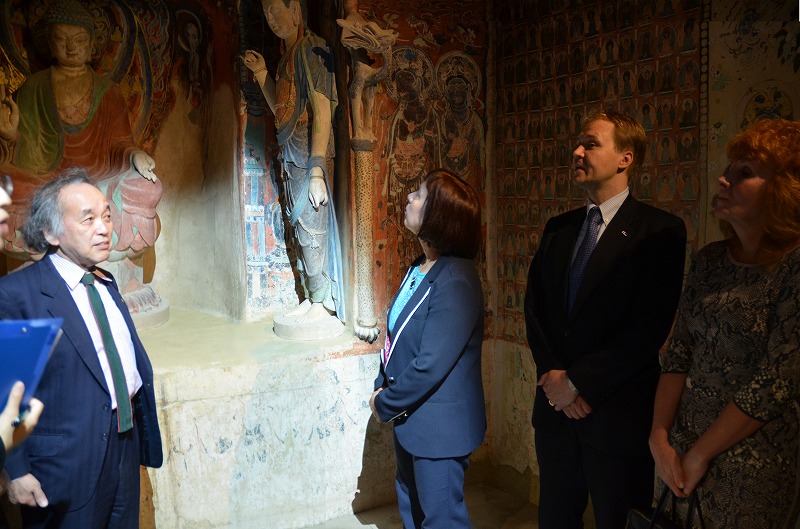
宮廻センター長の説明を聞きながら『敦煌莫高窟第57窟の再現』を見上げるレップス大臣
続いて、一行は本学のメイン・コンサートホールである奏楽堂へ移動し、藝大の音楽教育・研究の現場を見学しました。直井研二演奏研究員ならびに鈴木英一演奏企画室長 より、天井可変装置により空間の大きさを変えることで残響音を調節する特別な設備が施されていることなど、奏楽堂の特徴について紹介があると、ヴァレマ副学長は興味深く説明に耳を傾けておられました。
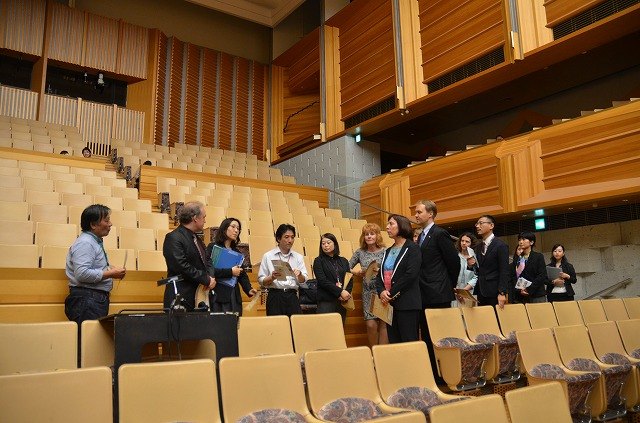
直井演奏研究員(左)と鈴木室長(中央左)の案内で奏楽堂を見学する一行
本訪問を通じて、「初めは小規模であっても、様々な形でエストニアの芸術系大学と本学との交流実績を積み上げていき、大きな成果に繋げることができれば 素晴らしい」という認識を共有するとともに、今後のエストニアと藝大との交流の可能性を確認し合った後、一行は大学を後にされました。
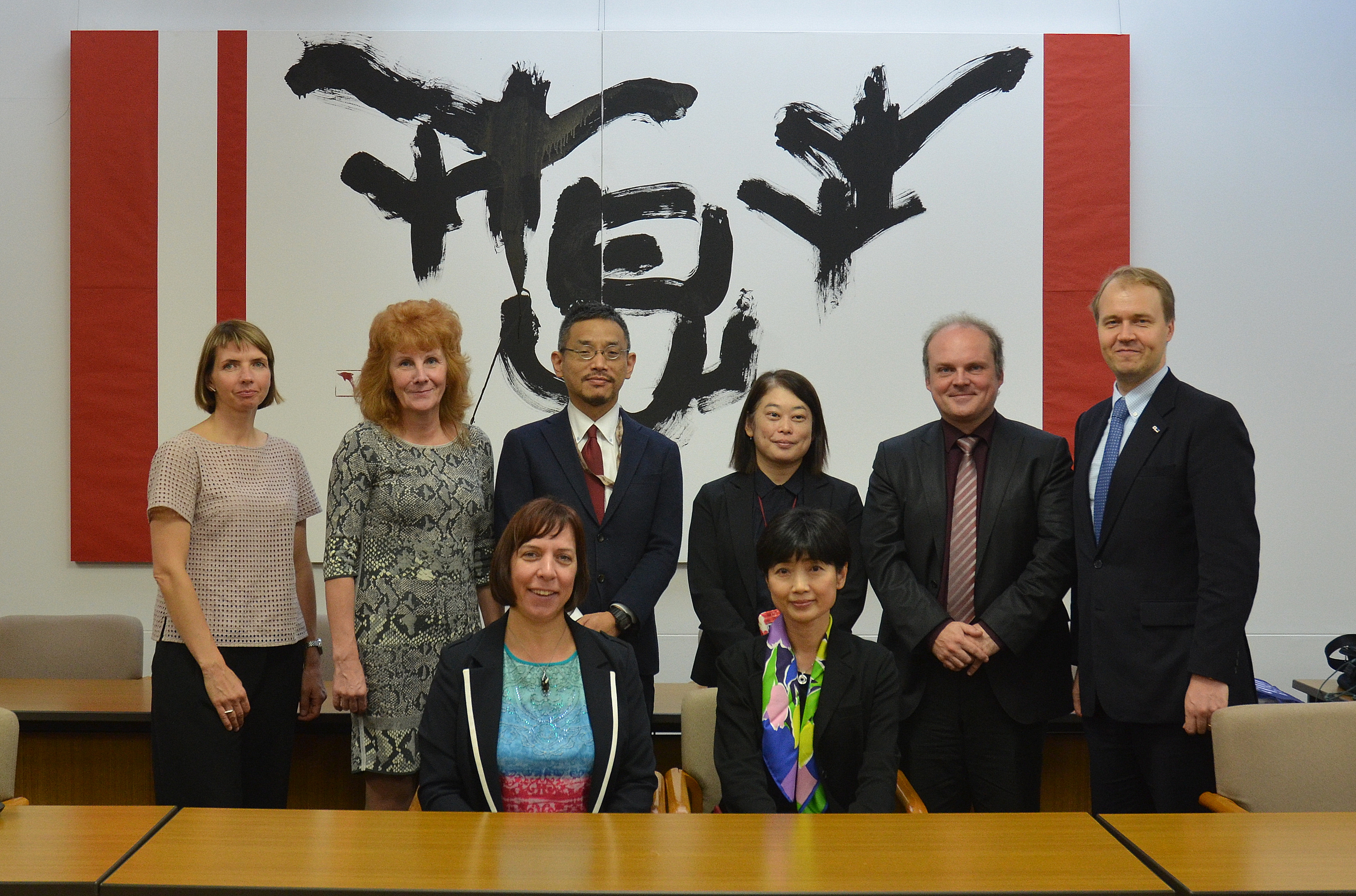
On September 29, 2017, a delegation from the Republic of Estonia visited Tokyo Geidai to help Estonian arts universities promote exchange and collaboration with our university. Among the guests were Minister Mailis Reps, and Secretary General Tea Varrak, as well as Adviser Anneli Roose, from the Ministry of Education and Research, and Vice Rectors Anne Pikkov and Henry-David Varema from the Estonian Academy of Arts and the Estonian Academy of Music, respectively, accompanied by Counselor Argo Kangro of the Estonian Embassy in Japan. They were welcomed at the Ueno campus by Professor Mitsuko Okamoto, Vice President for international affairs and campus diversity, along with Professor Katsuhiko Hibino, Dean of the Faculty of Fine Arts, and Project Associate Professor Yoko Yokota of the Global Support Center.
Following her welcome remarks, Professor Okamoto introduced Tokyo Geidai as an institution comprised of two faculties and four graduate schools with seventy international partner institutions. She also mentioned that the university, which is one of the designated universities for The Top Global University Project by the Japanese Ministry of Education, Culture, Sports, Science, and Technology (MEXT), has been working hard to provide a superior educational environment through various global initiatives such as collaborative curriculum with top arts universities across the world and special programs offered by world-renowned guest artists.

(From left) International Affairs Manager Shoji, Project Associate Professor Yokota, Professor Okamoto and Professor Hibino
Minister Reps provided the context of the visit that, amidst growing competition among European universities, the representatives of the two Estonian Academies would like to promote international exchange with institutions in Asia, especially Japan, since their academies had not developed extensive partnership in the region.

Education and Research Minister Reps
Following the opening comments by Minister Reps, Professor Pikkov stated that the Estonian Academy of Arts wished to establish a global network centering on Asian universities and promote exchange especially in the fields of design and animation. Professor Hibino explained that among a variety of programs offered at Tokyo Geidai’s Faculty of Fine Arts, the department of crafts represents a unique feature of the university’s education and research. The Japanese have traditionally believed that the beauty could be found in day-to-day life and Japanese artisans have been considered as artists and highly respected in the society, Professor Hibino added.
Touching on the co-work animation project between Japan, China, and South Korea, Professor Okamoto said that she would encourage more international student exchange programs.

Professor Pikkov of the Estonian Academy of Arts
Professor Varema explained that one fourth of the students at the Estonian Academy of Music were international students and many classes were taught in English. He continued that Japan was known for its high level of music education, and his academy therefore wished to seek collaboration with Tokyo Geidai in exchange of students and researchers. Associate Professor Yokota replied that Tokyo Geidai’s Facuty of Music had been actively involved in international exchange activities by inviting guest professors from abroad and holding a couple of joint concerts with its international partners every year. She also referred to the history and tradition of music in Estonia and showed expectations for the development of collaborative relationship, saying that many music students at Tokyo Geidai would be interested in working with Estonian students.

Professor Varema of the Estonian Academy of Music
After the meeting, the group moved to the University Museum, where Professor Masaaki Miyasako of the Public Collaboration Center welcomed the Estonian guests and gave a tour of The Grand Exhibition on the Silk Road, SOSin – DENSin Clone Cultural Property: Revitalization of Lost Time. Minister Reps and the delegation members were attentively listening to the explanation by Professor Miyasako that the techniques used to “clone” a cultural property not only aimed to represent the same materials and textures of the original but also reproduce the DNA of the work of art that is techniques, cultural backgrounds and spirituality carried by the cultural property.

Minister Reps looking up at the “cloned” Mogao Cave 57 in Dunhuang, China
Later the guests visited Sogakudo, the university’s main concert hall, where music education takes place. Performance Researcher Kenji Naoi as well as Mr. Eiichi Suzuki, Head of the Performance Planning and Management Section, explained to the guests the unique features of the concert hall. Professor Varema was carefully listening to the explanation that the hall is equipped with an adjustable ceiling which can change the size of the hall space for controlling reverberant sound in the hall.

Guests at Sogakudo with Performance Researcher Naoi (left) and Chief Suzuki (center left)
The guests left the campus after confirming that both the Estonian guests and the Tokyo Geidai members reached the common understanding that they would start with small collaborative undertakings, which could develop into larger projects in the future.



